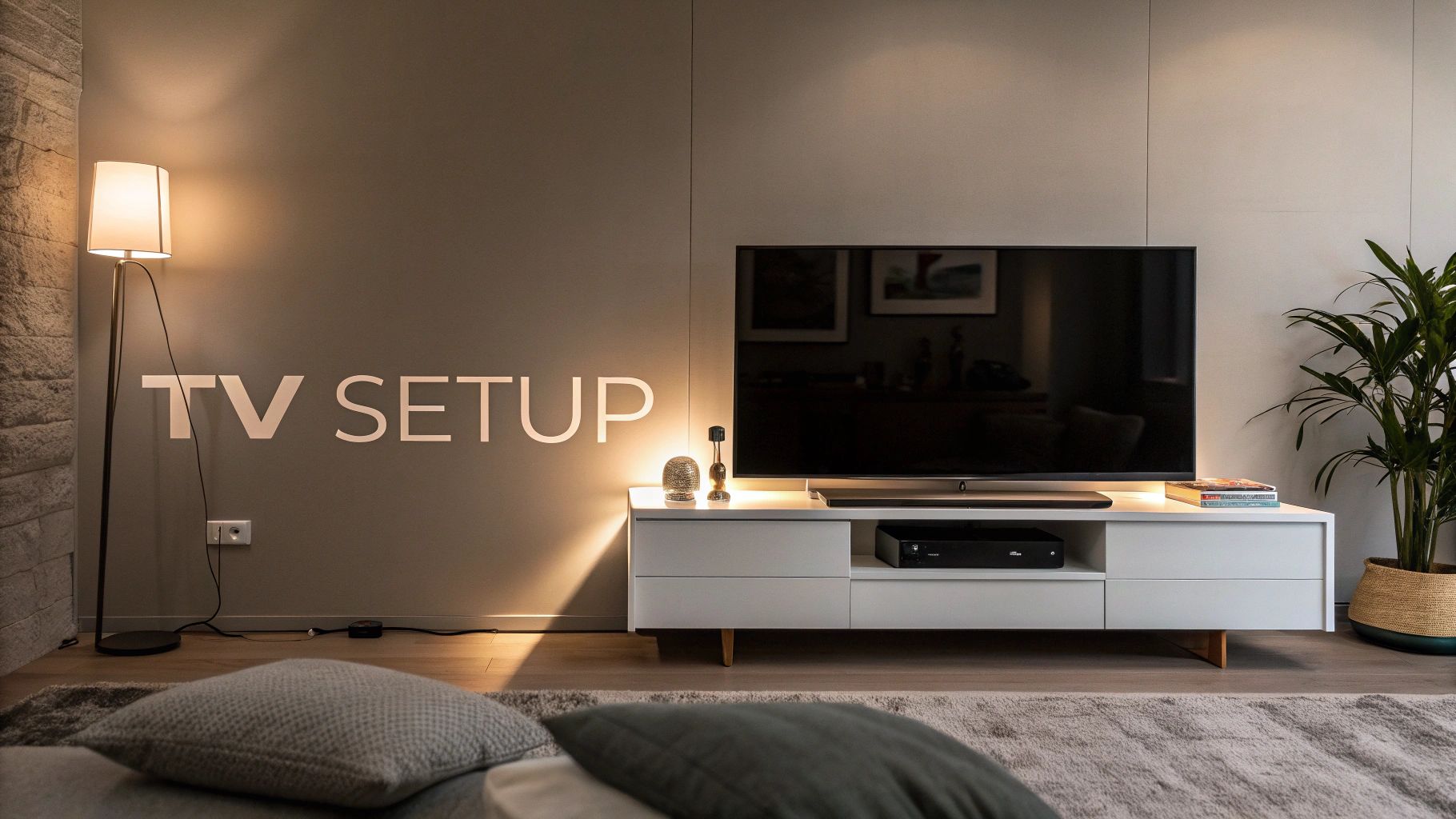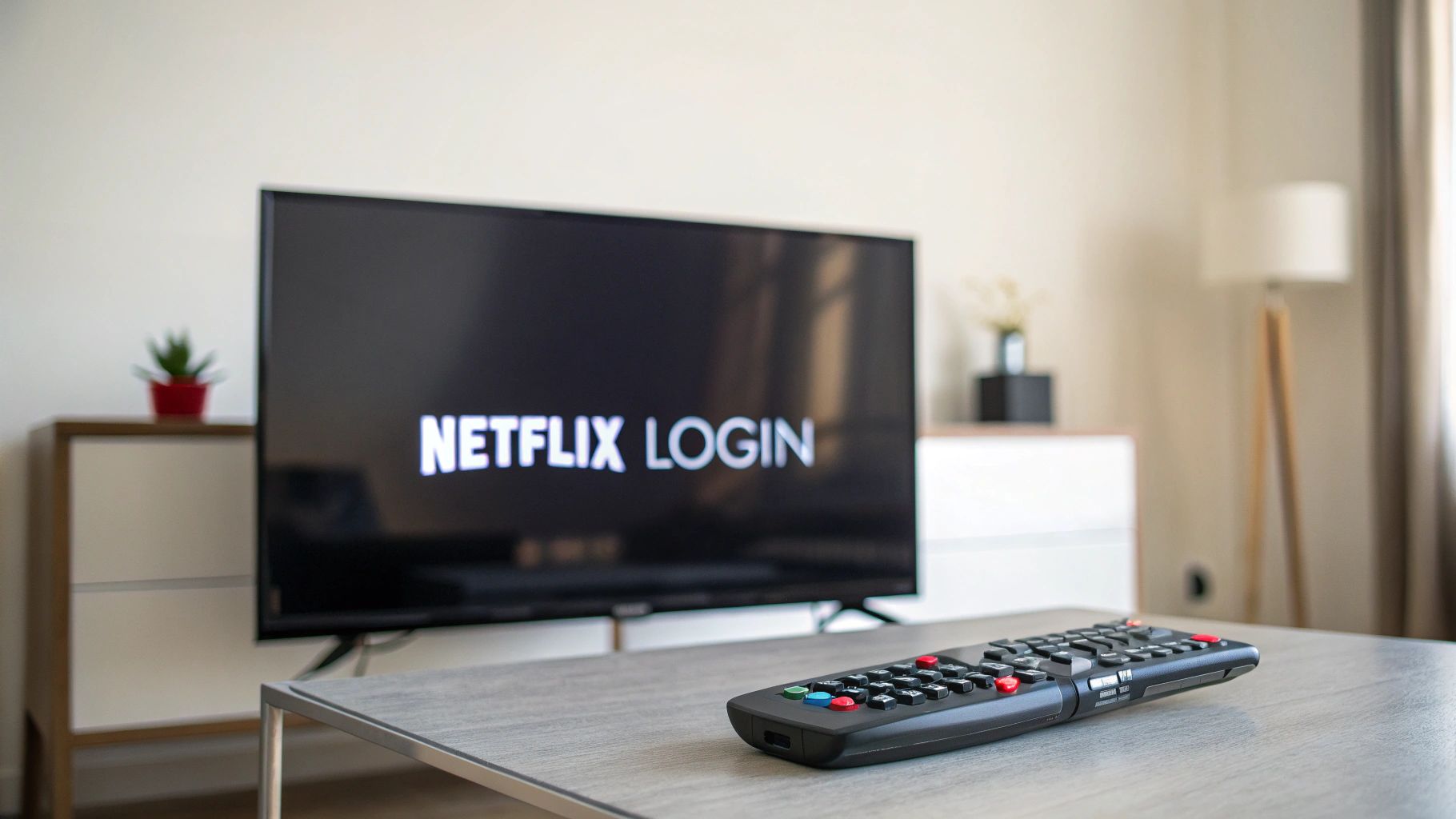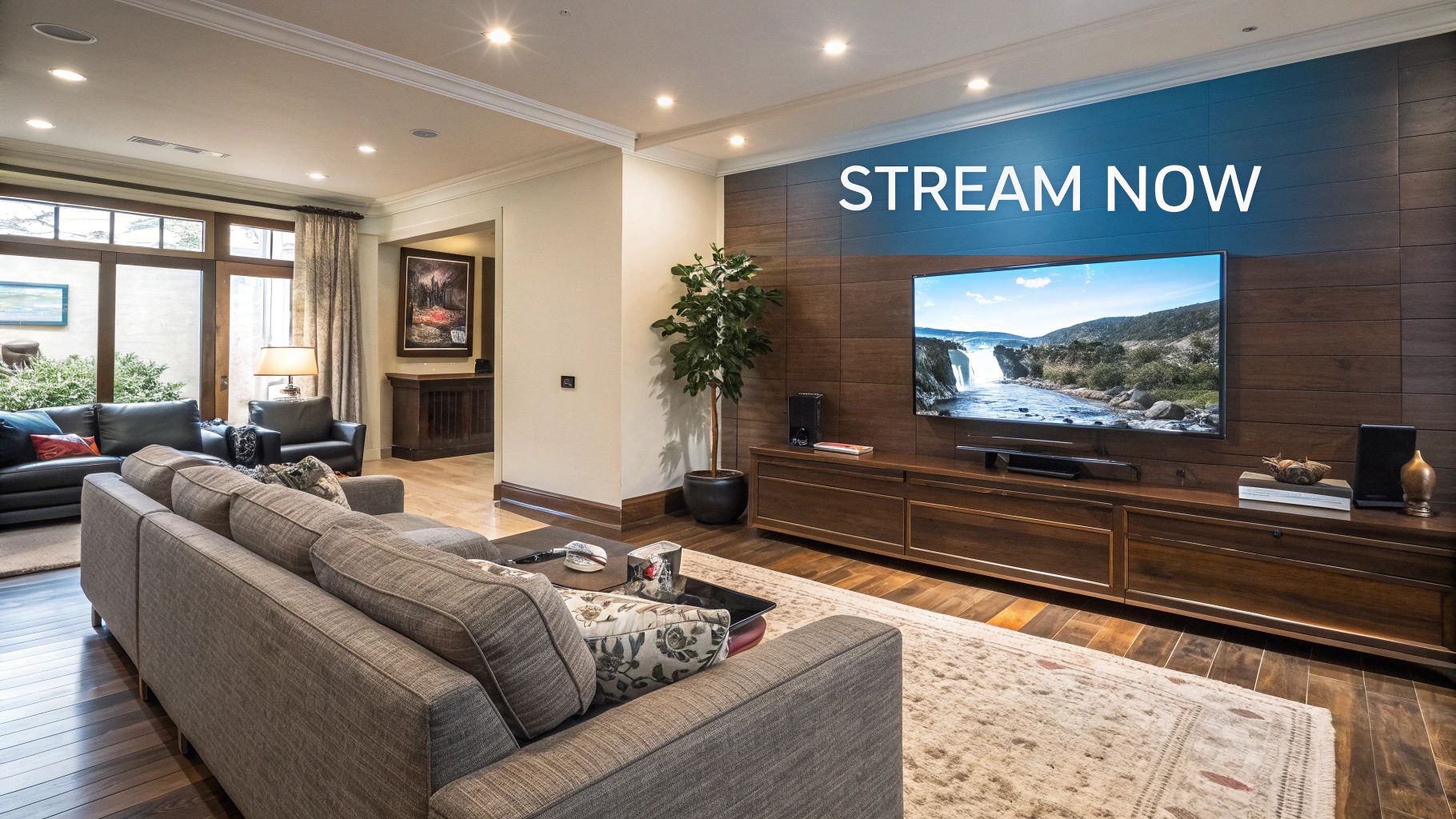
How to Connect to Netflix on TV: An Expert Setup Guide
Share
The Netflix Connection Landscape: Options That Work

Connecting your TV to Netflix unlocks a treasure trove of movies, TV shows, and documentaries. But finding the right connection method depends on your TV and current setup. This guide explores the various ways to access Netflix, helping you choose the best option for your home entertainment needs. Netflix's popularity is undeniable. In 2024, the platform boasted 277.6 million subscribers worldwide, a significant increase from 220.6 million subscribers in 2022. This growth reflects the broad appeal of streaming services and the accessibility of Netflix across devices, including Smart TVs. For a deeper dive into these numbers, check out these statistics: Learn more about Netflix subscriber statistics.
Built-In Smart TV Apps vs. External Streaming Devices
Many modern TVs include built-in Netflix apps, offering a streamlined and integrated viewing experience. Simply locate the app store on your Smart TV, download the Netflix app, and log in. For older Smart TVs or those with less intuitive interfaces, an external streaming device may be a better fit.
Devices like Roku, Amazon Fire TV, Apple TV, Chromecast, and gaming consoles provide a dedicated streaming experience. They often boast faster processors, regularly updated interfaces, and additional features such as voice search. This makes browsing Netflix and other streaming platforms a much smoother and more enjoyable experience. The best choice between a built-in app and an external device often comes down to your TV's capabilities and personal preferences.
Understanding Internet Speed Requirements
No matter your connection method, a stable and sufficiently fast internet connection is crucial for a smooth Netflix experience. Different video qualities require varying internet speeds. Standard Definition (SD) streaming typically requires about 3 Mbps, while High Definition (HD) requires around 5 Mbps. For the best quality 4K Ultra HD streaming, you'll need at least 25 Mbps.
Knowing these requirements can prevent buffering issues and help you assess if your current internet plan supports your desired streaming quality. It can also help you avoid unnecessary upgrades if your current internet speed is already adequate. Checking your internet speed is a smart first step before connecting to Netflix.
Choosing the Right Path for Your Setup
The ideal Netflix connection method hinges on a few key factors. If you own a newer Smart TV with a user-friendly interface, the built-in app is generally the easiest option. If you have an older TV, or simply prefer a more feature-rich streaming experience, an external streaming device can significantly enhance your Netflix viewing. Carefully considering your TV's age, interface, and your internet speed will help you determine the most efficient way to connect to Netflix and enjoy uninterrupted streaming.
To help you decide, let's compare the most common Netflix connection methods:
Netflix Connection Methods Comparison: This table compares different methods to connect Netflix to your TV based on ease of setup, cost, and required equipment.
| Connection Method | Equipment Needed | Setup Difficulty | Approximate Cost | Best For |
|---|---|---|---|---|
| Built-in Smart TV App | Smart TV with Netflix app | Easy | Free (with Netflix subscription) | Users with newer Smart TVs and simple setup preferences |
| Roku | Roku streaming device, HDMI cable | Easy | $30 - $100+ | Budget-conscious users and those wanting a simple interface |
| Amazon Fire TV | Amazon Fire TV Stick or Cube, HDMI Cable | Easy | $30 - $150+ | Users invested in the Amazon ecosystem and those wanting voice control |
| Apple TV | Apple TV device, HDMI Cable | Easy | $150+ | Users invested in the Apple ecosystem and seeking high-quality streaming |
| Chromecast | Chromecast device, HDMI cable, Smartphone/Tablet/Computer | Easy - Medium | $20 - $70 | Users wanting to stream from their existing devices |
| Game Console (PS4/PS5, Xbox) | Game console with Netflix app, HDMI cable | Easy | Cost of console | Gamers who also want to stream |
Key takeaways from this comparison include the affordability and simplicity of built-in apps and the added features and performance offered by external devices. Choosing the best method depends on your budget and technical comfort level.
Smart TV Netflix Setup: Brand-Specific Mastery

Connecting your smart TV to Netflix should be simple. This guide offers brand-specific instructions for a quick and efficient setup. We'll go beyond the basics, exploring the nuances of each platform. From initial setup and troubleshooting to optimizing your viewing, we've got you covered.
Navigating the Netflix App: Samsung Smart TVs
Finding the Netflix app on Samsung Smart TVs is generally straightforward. Grab your remote and head to the Smart Hub, usually indicated by a colorful home icon. Locate the Apps section. The Netflix app is often pre-installed and easily visible.
If not, download it from the Samsung app store. Once installed, log in with your Netflix credentials. For those looking to delve deeper into smart TV setups, check out this resource: How to master more complex smart TV setups.
LG Smart TVs: Accessing and Updating Netflix
For LG Smart TVs, the process is similar. Press the Home button on your remote to access the LG Content Store. Find the Netflix app. If an update is available, select the app and choose Update.
Regularly updating your Netflix app is essential. This ensures optimal performance and access to the latest features, giving you the best possible streaming quality.
Sony Smart TVs: Troubleshooting Connection Issues
Sony Smart TVs often feature a dedicated Netflix button on the remote, providing instant access. If you encounter connection problems, try restarting both your TV and internet router.
For persistent issues, go to the Settings menu on your TV. Navigate to Network, then select Refresh Internet Content. This often resolves common connection problems.
Optimizing Your Viewing Experience Across Brands
No matter your smart TV brand, a few tips can improve your Netflix viewing. Profile Management is crucial for personalized recommendations. Set up separate profiles for each household member for tailored suggestions.
Also, explore the audio and video settings within the Netflix app. Adjusting these settings allows you to optimize playback quality based on your internet speed and preferences. Choosing a lower video quality, for instance, can minimize buffering on slower connections.
Voice Control and Other Advanced Features
Many smart TVs now offer voice control for Netflix. Consult your TV's manual or online resources for specific voice commands. These shortcuts simplify browsing, searching, and playing content, streamlining your Netflix navigation.
Lastly, fine-tune your TV's picture settings. Features like motion smoothing or noise reduction can sometimes detract from the cinematic experience. Experiment to find the perfect balance for your viewing preferences. With a little tweaking, your smart TV can become the ultimate Netflix platform.
External Devices: Connecting Netflix Beyond Smart TVs

For TVs lacking smart functionality or those with outdated interfaces, external streaming devices offer a fantastic way to enjoy Netflix. These devices bridge the gap, bringing modern streaming capabilities to any TV equipped with an HDMI port. This section explores some popular options, highlighting their benefits for a seamless Netflix experience. You might also be interested in learning more about different connection methods: How to master different connection methods.
Roku: Simplicity and Value
Roku devices are renowned for their user-friendly interface and affordability. Setting up a Roku is simple: plug it into your TV's HDMI port, connect to Wi-Fi, and download the Netflix app. Roku remotes often feature dedicated Netflix buttons for instant access. Roku's platform-agnostic approach offers a wide array of streaming services beyond just Netflix.
Amazon Fire TV: Integration With the Amazon Ecosystem
The Amazon Fire TV Stick and Fire TV Cube integrate seamlessly with other Amazon services, like Prime Video and Alexa. This integration allows for voice search using the Alexa voice remote. You can ask Alexa to find specific Netflix shows, control playback, and even adjust the TV's volume. For instance, saying "Alexa, play Stranger Things on Netflix" launches the show directly. This hands-free control makes navigating Netflix incredibly convenient.
Apple TV: Premium Features and Performance
Apple TV delivers a premium streaming experience with a sleek interface and powerful hardware. Seamless integration with other Apple devices and services allows for content sharing and screen mirroring from your iPhone, iPad, or Mac. This makes enjoying Netflix content discovered on your phone a breeze. The Apple TV remote also features Siri voice control for easy navigation.
Chromecast: Streaming From Your Mobile Device
Chromecast operates differently than other streaming devices. It doesn't have its own dedicated interface or remote. Instead, you "cast" content from your smartphone, tablet, or computer to your TV. Your mobile device acts as the remote, allowing you to control playback and browse Netflix directly from your phone. Chromecast is an excellent option for those who prefer managing their streaming through a familiar interface.
Gaming Consoles: Entertainment Hub
Gaming consoles like PlayStation and Xbox also offer Netflix apps. If you already own a console, this provides a convenient way to access Netflix without an additional device. However, gaming consoles often have more complex interfaces than dedicated streaming devices and may require periodic software updates.
Choosing the Right Device For Your Needs
Each external streaming device offers unique advantages for connecting to Netflix on your TV. Consider your budget, technical comfort level, and existing devices when selecting the best fit for your home entertainment system. The following table provides a detailed comparison to help you make an informed decision.
To help you choose, we've compiled a table comparing popular streaming devices.
Streaming Device Specifications For Netflix
The table below provides a detailed comparison of popular streaming devices for accessing Netflix on non-smart TVs, highlighting key differences and similarities between each device.
| Device | Price Range | Resolution Support | Special Features | Remote Type | Netflix Experience Rating |
|---|---|---|---|---|---|
| Roku Streaming Stick 4K | $50 - $70 | Up to 4K HDR | Voice search, private listening | Voice remote with TV controls | Excellent |
| Amazon Fire TV Stick 4K Max | $55 - $75 | Up to 4K HDR | Alexa voice control, fast Wi-Fi 6 | Alexa voice remote | Excellent |
| Apple TV 4K (32GB) | $149 - $169 | Up to 4K HDR | Siri voice control, Apple device integration | Siri remote | Excellent |
| Chromecast with Google TV (HD) | $30 - $40 | Up to 1080p HD | Google Assistant, personalized recommendations | Voice remote with Google Assistant | Good |
| PlayStation 5 | $400 - $500 | Up to 4K HDR | Gaming, Blu-ray playback | DualSense wireless controller | Good |
| Xbox Series S | $299 - $399 | Up to 1440p QHD | Gaming, digital content library | Xbox Wireless Controller | Good |
This comparison allows you to weigh features against cost, helping you find the perfect balance for your needs. Ultimately, the best device depends on your individual preferences and existing home entertainment setup.
Connection Quality: Elevating Your Netflix Experience

A strong internet connection is essential for a satisfying Netflix experience. This section explores practical ways to optimize your connection for buffer-free streaming. For a seamless experience, compare different streaming devices. You can find a helpful streaming device comparison online.
Router Placement: A Surprisingly Significant Factor
The placement of your router significantly impacts Wi-Fi signal strength. Ideally, position it in a central, unobstructed location, away from walls and furniture. Elevating the router can also improve signal distribution.
Think of it like a radio tower: a clearer broadcast path means a stronger signal. This ensures a consistent and reliable connection throughout your home.
Minimizing Network Congestion: Competing Devices
Multiple devices using the same network can cause network congestion, impacting streaming quality. Imagine your internet connection as a highway; too many devices using the same bandwidth creates buffering.
Consider pausing downloads or uploads on other devices while streaming. This frees up bandwidth and prioritizes your Netflix stream.
Mastering Netflix Quality Settings
Netflix offers quality settings within the app, letting you adjust video resolution to match your internet speed. This is especially helpful during peak usage.
Lowering the resolution prevents buffering without significantly impacting viewing enjoyment. Opting for HD instead of 4K during peak hours can dramatically improve playback smoothness. This allows you to enjoy your show without interruptions.
Mesh WiFi Systems: Evaluating Their Streaming Impact
Mesh WiFi systems promise improved coverage and performance by creating a unified network with multiple access points. This extends the reach of your Wi-Fi signal.
However, their effectiveness for streaming depends on factors like the specific system and your home's layout. While mesh systems often reduce dead zones, they might not fix buffering from a slow internet connection.
Identifying Internet Service Provider Bottlenecks
Sometimes, your internet service provider (ISP) causes persistent buffering. Performing a speed test during peak Netflix hours can help determine if your ISP delivers the promised speeds.
Consistent underperformance suggests an ISP bottleneck. Contact your ISP to discuss solutions or explore alternative providers. Addressing the root cause of connection issues, whether router placement or ISP limitations, ensures a consistently enjoyable Netflix experience.
Troubleshooting: Solving Netflix Connection Challenges
Connecting your TV to Netflix should be simple, but sometimes issues arise. This guide offers practical solutions to common Netflix connection problems. We'll help you determine if the problem originates from your device, network, or Netflix itself, saving you time and frustration.
Diagnosing the Source of the Problem
Before trying solutions, pinpoint the source of the connection problem. Is it your device, network, or Netflix's servers? Start by checking the Netflix app on another device, like your phone or tablet. If it works elsewhere, the issue likely lies with your TV or its connection. If Netflix isn't working on any device, the problem may be with Netflix's servers or your internet connection. Check Netflix's server status online or use a website like DownDetector to see if others are experiencing similar issues.
Common Error Codes and Their Fixes
Netflix often displays error codes that provide clues about the issue. The NW-2-5 error usually indicates a network connectivity problem. Try restarting your router and modem. If that doesn't resolve the issue, check your internet connection on other devices. You can find more helpful information in our article on how to master network connectivity issues. Another common error is the UI-800-3 error, which suggests a problem with the Netflix app data on your device. Clearing the app's cache or reinstalling the app can often fix this.
Eliminating Buffering Issues
That annoying spinning wheel, otherwise known as buffering, is often caused by a slow or unstable internet connection. Make sure your internet speed meets Netflix's requirements: at least 3 Mbps for SD, 5 Mbps for HD, and 25 Mbps for 4K. Try moving your router to a central location and minimize the number of devices using the network at the same time. If buffering continues, try lowering the video quality within the Netflix app.
Fixing Audio/Video Sync Problems
Out-of-sync audio and video can disrupt your viewing experience. This issue can be caused by a slow processor in your streaming device or TV. Restarting the device can sometimes help. Also, ensure your TV's software and the Netflix app are up to date, as outdated software can impact performance.
When to Contact Netflix Support
If you've tried everything and the problem persists, contact Netflix support. Be ready to explain the issue, any error codes, and the steps you've already taken. This helps support agents diagnose the problem quickly. Provide details about your TV model, streaming device (if you're using one), and internet service provider. This information can expedite the process. Netflix support can often provide tailored solutions based on your specific setup.
Personalizing Netflix: Profiles and Parental Controls
Connecting to Netflix on your TV is just the first step. Truly maximizing your viewing experience comes down to personalization. This section explores how to transform Netflix from a generic streaming service into a customized entertainment hub for everyone in your household.
Managing Profiles for Personalized Recommendations
Netflix profiles are key to personalized recommendations. Each profile tracks individual viewing habits, influencing the suggested titles on the home screen. This ensures that each user sees content aligned with their interests. Think of it like having separate movie queues at the video store, customized for each family member.
To create or manage profiles on your TV, navigate to the Netflix app, then select the Profiles icon, usually located in the top right corner. From here, you can add new profiles, edit existing ones, or even delete profiles you no longer use.
Resetting Recommendations When Algorithms Miss the Mark
Sometimes, Netflix's algorithms misinterpret viewing habits. For example, watching a children's movie with your kids might suddenly fill your recommendations with animated content.
If this happens, you can reset your viewing history for a specific profile. Within the Profile Management section, select the profile you want to adjust and look for the Viewing Activity option. This lets you remove specific titles from your history, recalibrating the recommendation engine. This provides a way to fine-tune suggestions and keep them relevant to your current tastes.
Implementing Content Filters and Parental Controls
Protecting younger viewers is crucial in a world of on-demand entertainment. Netflix offers robust parental controls, allowing you to set maturity ratings for each profile. This filters out content deemed inappropriate for specific age groups.
Within the Account Settings (often accessible through a web browser, not directly on your TV), you can configure Parental Controls with a PIN. This gives you granular control over what each profile can access, providing a safe viewing environment for children. Parental controls offer a vital layer of protection, balancing access with age-appropriate content restrictions.
Lesser-Known Profile Settings That Enhance Your Experience
Beyond basic profile management, exploring lesser-known settings can further enhance your Netflix experience. For instance, some TVs allow you to designate a profile as the "Auto-Login" profile. This simplifies connecting to Netflix, as the designated profile automatically loads when the app is launched.
You can also customize language preferences for subtitles and audio, ensuring everyone enjoys content in their preferred format. These small adjustments significantly improve user experience, creating a truly personalized viewing environment for each member of your household.
Managing Multiple Viewers With Different Preferences
Juggling multiple viewers with diverse tastes is easier with effective profile management. Consider a family with varying interests: parents who enjoy documentaries, teenagers who prefer action movies, and younger children who love cartoons.
By establishing and maintaining separate profiles, Netflix can cater to each person's viewing preferences. This prevents conflicts over recommendations and ensures everyone finds something they enjoy. This personalized approach transforms Netflix from a single streaming service into a versatile entertainment hub for the entire family.
Ready to unlock the full potential of your subscriptions? AccountShare makes it possible to access premium services at a fraction of the cost through the power of group buying. Check out AccountShare today and start saving: Experience the benefits of shared subscriptions with AccountShare.
